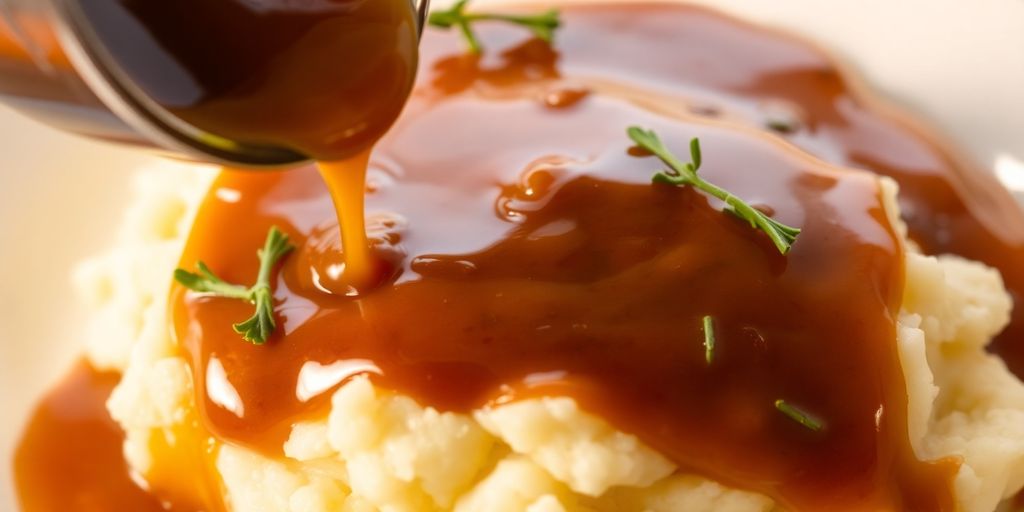Gravy might seem like a small part of a meal, but it can make a huge difference. Whether you’re serving up a holiday feast or a simple weeknight dinner, knowing how to make gravy can elevate your dishes to the next level. It’s not as complicated as it seems, and once you get the hang of it, you’ll wonder why you ever used store-bought. Let’s break down the basics of making delicious homemade gravy.
Key Takeaways
- Gravy starts with a roux made from butter and flour, which thickens the sauce.
- Using good quality stock or broth is essential for flavorful gravy.
- You can make gravy without drippings by using stock cubes for added flavor.
- Adjusting the thickness of your gravy is as simple as adding more stock or flour.
- Experiment with different herbs and spices to customize your gravy flavor.
How to Make Gravy – Understanding the Basics of Gravy Making
Gravy might seem simple, but there’s a bit of magic in getting it just right. Whether you’re using drippings from a roast or starting from scratch, understanding the core elements of gravy can elevate your dish to the next level. Let’s break down the essential components.
The Role of Ingredients in Gravy
When it comes to making gravy, the ingredients you choose are everything. Each component plays a crucial role in flavor and texture. The fat, whether it’s butter or drippings, provides richness. Flour or a similar thickening agent gives the gravy its body. And the liquid, often stock or broth, is the flavor base. You can add seasonings like salt, pepper, and herbs to fine-tune the taste.
Importance of Roux in Gravy
A roux is the backbone of many gravies. It’s a simple mixture of fat and flour, cooked together to create a thickening agent. The key to a good roux is patience: cook it slowly over medium-low heat until it turns a golden brown. This process not only thickens the gravy but also adds a nutty, rich flavor. Remember, a roux can make or break your gravy, so give it the attention it deserves.
Choosing the Right Stock for Gravy
The stock you choose can make a huge difference in the final flavor of your gravy. Chicken, beef, or vegetable stock are common choices, each bringing its own unique taste. If you’re aiming for a delicious homemade gravy, consider using a high-quality stock or broth. Some folks even mix chicken and beef stock for a richer flavor. Whatever you choose, ensure it’s something you’d enjoy on its own, as it will be the foundation of your gravy.
How to Make Gravy – Essential Ingredients for Perfect Gravy

Using Stock Cubes for Flavor
When you’re aiming for a gravy that packs a punch, stock cubes are your best friend. They’re super handy, especially if you don’t have homemade stock on hand. You can mix chicken and beef stock cubes to get a richer flavor and a deeper brown color. Here’s a quick tip: dissolve them in hot water before adding them to your roux for an even distribution of flavor.
The Magic of Butter and Flour
Butter and flour are the dynamic duo in gravy-making. They come together to form a roux, which is the base for thickening your gravy. Use unsalted butter, so you can control the saltiness of your final dish. Melt the butter in a pan, stir in the flour, and cook until it turns a golden color. This is what gives your gravy that smooth, luscious texture.
Spices and Herbs for Gravy
A sprinkle of spices can transform your gravy from bland to brilliant. Consider using onion powder, garlic powder, thyme, and a bit of sage. These add layers of flavor without overpowering your dish. Avoid large herb pieces to keep your gravy smooth. Salt and pepper are essential, but feel free to experiment to match your taste preferences.
Creating the perfect gravy is about balancing flavors and textures. With the right ingredients, you can make a gravy that complements any meal.
How to Make Gravy – Step-by-Step Guide to Making Gravy
Preparing the Roux
First things first, you’ll need to whip up a roux. It’s a simple mix of butter and flour, but it’s the backbone of a good gravy. Melt about 4 tablespoons of butter in a pan over medium heat. Once it’s melted, sprinkle in 1/4 cup of flour. Stir continuously—it’ll start to bubble and turn a lovely golden brown. This is your roux, and it’s what gives your gravy its thickness. Don’t let it burn, though. Keep an eye on it and stir, stir, stir!
Incorporating the Stock
With your roux ready, it’s time to add some flavor. Slowly pour in about 2 cups of stock—chicken, beef, or veggie, whatever you fancy. As you pour, keep whisking to make sure everything blends smoothly. The stock should be warm to help it mix better with the roux. Once it’s all in, let it simmer. You’ll see it starting to thicken up into a beautiful, glossy gravy.
Adjusting Consistency and Flavor
Now, here’s where you make it yours. Taste your gravy. Need more salt? A pinch of pepper? Maybe a dash of onion powder or thyme? Go ahead and tweak it. If it’s too thick, add a bit more stock. Too thin? Let it simmer a bit longer. The key is to keep tasting and adjusting until it’s just right.
“Gravy making is a bit like a dance—it’s all about finding the right rhythm and balance.”
And there you have it, a simple, delicious gravy that you can pour over just about anything. Enjoy!
How to Make Gravy – Tips for Achieving the Perfect Gravy Consistency
Avoiding Lumps in Gravy
Nobody wants lumpy gravy. To dodge this common pitfall, whisk continuously as you combine your flour or cornstarch with the fat. Whether you’re using drippings or butter, the key is to keep stirring until your roux is smooth before adding the liquid. If you do find lumps forming, grab a sieve and strain the gravy to remove them. Patience is key—don’t rush this step!
Thickening Gravy Without Drippings
No drippings? No problem. You can still make a thick, flavorful gravy by using a simple roux made from butter and flour. Start by melting butter in a pan, then stir in the flour until it forms a paste. Gradually add your chosen stock—be it chicken, beef, or vegetable—while stirring constantly. The gravy will thicken as it simmers. If you want it thicker, just let it cook a bit longer, or add more flour mixed with a little water.
Balancing Flavors in Gravy
Getting the flavor balance right is crucial for delicious gravy. Start with a good-quality stock and taste your gravy as it cooks. If it’s too bland, a splash of soy sauce or Worcestershire sauce can add depth. For an extra kick, sprinkle in some herbs like thyme or sage. On the flip side, if it’s too salty, a splash of cream or a small potato can help mellow it out. Remember, the best gravy is one that complements your dish, not overpowers it.
Smooth, flavorful gravy can elevate any meal. By focusing on consistency and taste, you can create a sauce that makes even the simplest dishes shine.
Variations of Homemade Gravy
Making Vegetarian Gravy
Creating a vegetarian gravy is simple and delicious. Instead of using meat-based stocks, opt for a rich vegetable broth. You can enhance the flavor with mushrooms, which add a savory depth. Mushrooms are the secret ingredient that gives vegetarian gravy its hearty taste. Sauté them with onions and garlic before adding flour to make the roux. Finish it off by whisking in vegetable broth and seasoning with your favorite herbs.
Creating Gluten-Free Gravy
For those avoiding gluten, making a gluten-free gravy is just as easy. Use gluten-free flour or cornstarch instead of regular flour to thicken the sauce. Start by melting butter and stirring in your gluten-free thickener until smooth. Slowly add your choice of stock, whether it be chicken, beef, or vegetable, and stir until it reaches the desired thickness. Adjust the seasoning with salt and pepper to taste.
Experimenting with Different Stocks
The type of stock you use can completely change the flavor profile of your gravy. Here are some options:
- Chicken stock for a lighter, more traditional flavor.
- Beef stock for a rich, hearty taste.
- Vegetable stock for a vegetarian option.
- Try mixing stocks for a unique flavor twist.
Experimenting with different stocks can lead to a variety of delicious gravy recipes, each offering its own unique taste and character. Don’t be afraid to try something new and find your perfect gravy match.
Serving Suggestions for Homemade Gravy
Pairing Gravy with Meats
Gravy is a classic companion to meats, enhancing their natural flavors. Pour it generously over roasted chicken or turkey for a traditional touch. It’s also perfect for beef dishes; try it with a pot roast or meatloaf. For a hearty meal, serve gravy with pork chops or lamb. Remember, the type of gravy can complement the meat’s flavor – think beef gravy for beef dishes, and chicken or turkey gravy for poultry.
Gravy Over Vegetables and Sides
Don’t limit gravy to just meats. It’s a fantastic addition to vegetables and side dishes too. Drizzle it over mashed potatoes or roasted root vegetables for an extra layer of flavor. Try it with steamed greens like broccoli or green beans for a tasty twist. Gravy can also elevate your rice or pasta dishes, giving them a rich, savory touch.
Using Gravy in Casseroles and Pies
Gravy isn’t just for pouring; it’s a secret weapon in casseroles and pies. Use it as a base for shepherd’s pie or chicken pot pie to ensure every bite is moist and flavorful. Incorporate it into casseroles for added depth and richness. Whether it’s a beef and vegetable bake or a chicken and rice casserole, gravy can transform a simple dish into something extraordinary.
Homemade gravy is more than just a sauce; it’s a versatile ingredient that can turn ordinary meals into something special. Whether you’re using it to complement meats, enhance vegetables, or enrich casseroles, its ability to bring flavors together is unmatched.
Troubleshooting Common Gravy Problems

Fixing Watery Gravy
Gravy that’s too thin can be a letdown, but it’s a common issue. To thicken it up, mix a tablespoon of cornstarch with a tablespoon of cold water to create a slurry. Gradually whisk this into your simmering gravy, and watch it thicken. If you prefer not to use cornstarch, you can also use flour. Just be sure to mix it with a bit of butter first to avoid lumps.
Dealing with Overly Salty Gravy
Accidentally heavy-handed with the salt? Don’t worry, it happens to the best of us. To fix salty gravy, start by adding a small amount of sugar or honey to balance the saltiness. If that doesn’t do the trick, try stirring in a bit of cream or unsalted butter. Another method is to add a peeled potato to the gravy while it simmers, as it can absorb some of the excess salt.
Correcting Gravy Color and Texture
Sometimes, gravy ends up looking a little pale or the texture isn’t quite right. For a richer color, consider using a dash of soy sauce or a bit of browning sauce. These add depth without altering the flavor significantly. If your gravy’s texture is off, ensure you’re whisking continuously while it cooks to avoid lumps. If lumps do form, a quick blitz with an immersion blender can smooth things out.
A perfectly made gravy can elevate any meal, but even the best cooks encounter hiccups. With a few simple tricks, you can turn potential disasters into delicious successes.
Keeping your gravy warm without forming a skin can also help maintain its perfect texture until it’s time to serve.
Wrapping It Up
So there you have it, making gravy from scratch isn’t rocket science after all. With just a few basic ingredients and a little bit of patience, you can whip up a delicious sauce that will make any meal feel special. Whether you’re pouring it over mashed potatoes, turkey, or even just some veggies, homemade gravy is a game-changer. Plus, once you get the hang of it, you’ll never want to go back to those store-bought packets again. Give it a try, and you might just find yourself making gravy for more than just the holidays. Happy cooking!
Frequently Asked Questions
How can I make my gravy thicker?
To make the gravy thicker, you can add a mixture of flour and water, called a slurry, or use cornstarch mixed with cold water. Stir it into the gravy while it’s simmering until it reaches the thickness you like.
Is it possible to make gluten-free gravy?
Yes, you can make gluten-free gravy by using cornstarch or a gluten-free flour blend instead of regular flour to thicken it.
How should I store leftover gravy?
Store leftover gravy in an airtight container in the fridge. It might thicken as it cools, so reheat it and add a bit of water or stock to thin it out if needed.
Can I freeze gravy?
Yes, you can freeze gravy. Place it in a freezer-safe container or bag, leaving some space for expansion. Use it within 4 to 6 months for the best taste.
What can I do if my gravy is too salty?
If your gravy is too salty, try adding a bit of sugar or a splash of vinegar to balance the flavors. You can also add more liquid, like water or unsalted stock, to dilute the saltiness.
Why is my gravy lumpy and how can I fix it?
Lumpy gravy can happen if the flour isn’t mixed well. To fix it, strain the gravy through a fine mesh sieve or use a blender to smooth it out.




